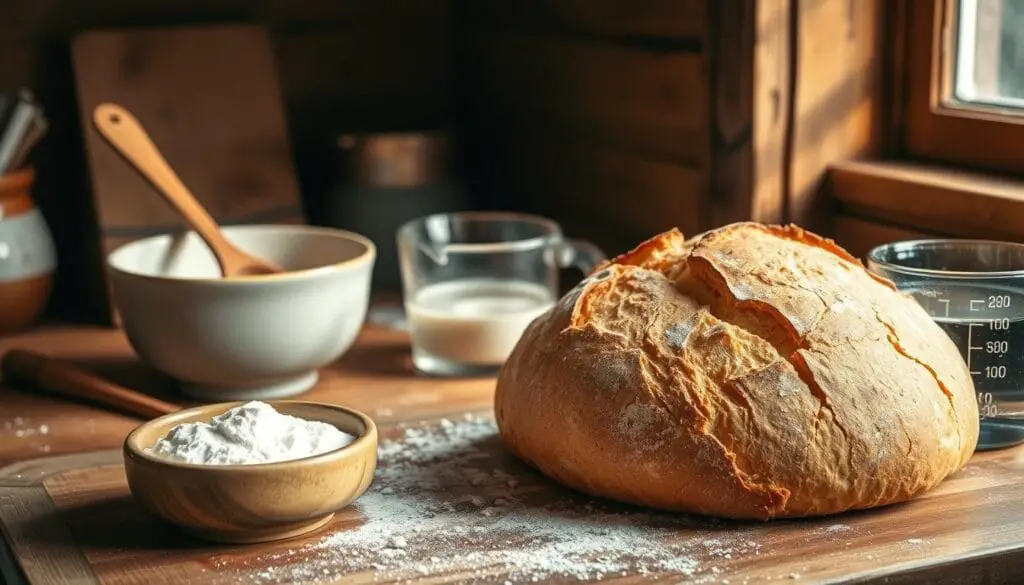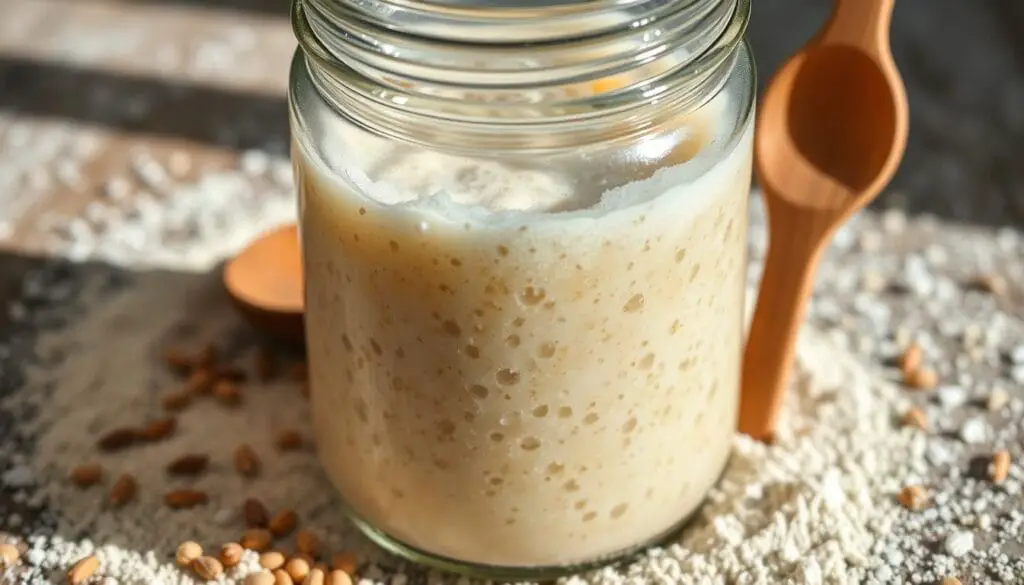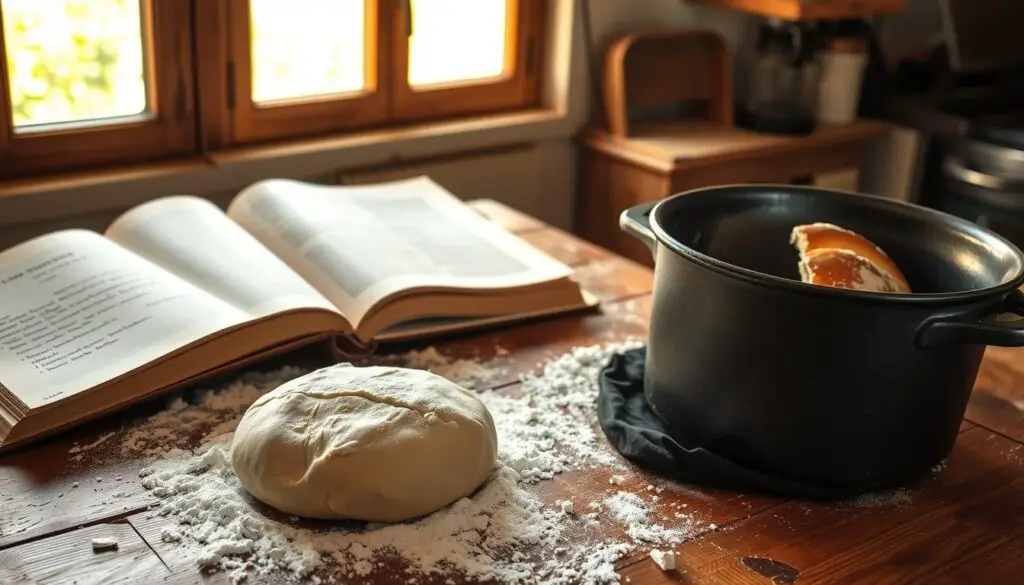- Crusty, tangy, and ready in hours. This one day sourdough skips the waiting, not the taste. Perfect for when you want bakery-level bread on a tight schedule.
Imagine the smell of freshly baked, crusty bread filling your kitchen. It’s all done in just one day with one day sourdough. This method is perfect for busy home bakers who can’t fit long fermentation times into their schedules.
With this easy recipe, you can enjoy the taste and texture of artisan bread in a single day. It’s a game-changer for making homemade bread quickly..
Table of Contents

Key Takeaways
- Discover the secrets of one day sourdough, a quick and easy way to make homemade bread
- Learn how to create a wild yeast starter in just a few hours, without the need for long-term maintenance
- Unlock the science behind fast fermentation and how it results in a delicious, crusty loaf
- Explore the essential ingredients and equipment needed for baking success
- Master the no-knead method for a hands-off approach to dough development
- Achieve a professional-looking loaf with expert shaping and scoring techniques
- Understand the importance of the baking environment and how to create the perfect crust
Understanding the Magic of One Day Sourdough
Making sourdough bread doesn’t have to take a lot of time. The one day sourdough recipe is quick and easy. It uses wild yeast starters for fast fermentation, giving you tasty bread in less time.
What Makes This Recipe Different
Traditional sourdough recipes take a long time, sometimes over 24 hours. But the one day sourdough uses a special wild yeast starter. This starter makes the dough rise faster, saving you time.
Benefits of Quick Fermentation
- Time-saving: You can bake fresh sourdough in just one day, perfect for those with busy lives.
- Exceptional Flavor: The wild yeast starter adds a tangy, complex taste, just like traditional sourdough.
- Improved Texture: The dough rises quickly, giving you a light, airy crumb and a crisp crust.
The Science Behind Fast Sourdough
The secret to one day sourdough is the wild yeast starter. Unlike commercial yeast, it’s a mix of many microbes. These microbes work together to ferment the dough fast, creating a strong flavor in less time.
| Traditional Sourdough | One Day Sourdough |
|---|---|
| Fermentation Time: 24-48 hours | Fermentation Time: 4-8 hours |
| Yeast: Commercial Yeast | Yeast: Wild Yeast Starter |
| Flavor: Mild, Subtle | Flavor: Tangy, Complex |
| Crumb Texture: Dense | Crumb Texture: Light, Airy |
Essential Ingredients for Your Artisan Bread
Making the perfect artisan bread starts with the right ingredients. The flour is the base, and the seasonings add depth. Each part is key to a great bread baking experience.
Flour Power
High-quality flour is the heart of artisan bread. Choose organic, stone-ground whole wheat or all-purpose flour. These flours give your dough the right texture and structure.
Hydration Station
Water is vital for your dough. Aim for a 70-80% hydration level. This balance is crucial for the dough’s texture and pliability.
Seasoning Secrets
- Salt: A pinch of high-quality sea salt enhances the flavor and controls the fermentation process.
- Herbs and Spices: Try rosemary, thyme, or fennel seeds for a unique taste.
With the right ingredients, you’ll make an amazing artisan bread. It will wow your family and friends.
“The secret to making the perfect loaf of bread is all in the ingredients.”
Required Tools and Equipment for Baking Success
To bake one day sourdough bread at home, you need some key tools and equipment. These tools range from basic kitchen items to specialized baking tools. Having the right gear is crucial for your bread baking journey.
Basic Kitchen Tools
- Mixing bowl – A large, sturdy mixing bowl is necessary for kneading and shaping the dough.
- Measuring cups and spoons – Accurate measurements are key for consistent bread baking.
- Dough scraper – This versatile tool helps with handling, shaping, and cleaning the dough.
- Bench scraper – Used for cutting and dividing the dough, as well as cleaning work surfaces.
- Parchment paper – Lining baking surfaces with parchment paper prevents sticking and simplifies transfer.
Optional Professional Equipment
While not necessary, some professional-grade baking tools can elevate your one day sourdough:
- Digital scale – Weighing ingredients precisely ensures consistent results.
- Stand mixer – A stand mixer with a dough hook can make kneading and mixing the dough much easier.
- Banneton proofing basket – These baskets help shape and support the dough during the final proofing stage.
- Dutch oven or baking stone – These items create a professional-grade baking environment for a crisp crust.
Baking Vessels and Surfaces
The type of baking vessel or surface you use can also impact the final appearance and texture of your one day sourdough bread:
| Baking Vessel | Benefits |
|---|---|
| Loaf pan | Ideal for a classic sandwich-style loaf with a soft, even crust. |
| Baking sheet | Allows for a free-form, artisanal shape with a crispy crust all around. |
| Dutch oven | Creates a steamy baking environment for a beautifully crusty loaf. |
Choosing the right tools and equipment can greatly enhance your bread baking experience. It also improves the quality of your one day sourdough loaves.
Creating Your Wild Yeast Starter Quickly
Making a strong wild yeast starter is key to baking perfect one day sourdough bread. It uses natural yeasts to create a tasty fermented dough without commercial yeast. This guide will show you how to quickly make your own wild yeast starter. You’ll learn the secrets of making artisanal bakery technique.
You’ll need a clean glass jar, filtered water, and whole wheat flour to start. Mix equal parts flour and water in your jar, stirring well to add air. Then, cover it with a cloth or lid that breathes. Let it sit at room temperature for 24 hours.
After a day, you’ll see tiny bubbles on the surface. This means the wild yeasts are working. Throw away half the starter, then add fresh flour and water. Do this for 2-3 days, watching it grow and smell sour.
| Day | Action |
|---|---|
| 1 | Mix equal parts flour and water, cover, and let rest at room temperature. |
| 2-3 | Discard half the starter, then feed with equal parts fresh flour and water. |
| 4+ | Monitor the starter’s growth and activity, continuing to discard and feed as needed. |
With patience and care, your wild yeast starter will be ready for your sourdough recipe. Keep it alive by regularly discarding and feeding it. This way, you’ll have a great leavening agent for all your bread.

Mixing and Developing the Perfect Dough
Making the perfect one day sourdough loaf begins with mixing and developing the dough right. It’s all about the techniques and temperature control. Each step is key to a dough that will rise well in the oven.
Proper Mixing Techniques
Start by mixing your no knead bread ingredients in a big bowl. Use a wooden spoon or your hands to mix flour, water, salt, and fermented dough starter. Fold and turn the dough gently to avoid overmixing. This helps build the gluten without making the bakery technique tough.
Understanding Dough Consistency
- The dough should be slightly sticky but not too wet or dry.
- If it’s too dry, add a bit more water. If too wet, add a little flour.
- Watch the dough’s texture and adjust as needed for the perfect balance.
Temperature Control Tips
Keeping the right temperature is key for your one day sourdough. Aim for a dough temperature of 75-85°F (24-29°C) during mixing and bulk fermentation. Adjust the room temperature, ingredient temperature, or use a proofing box to keep it in this range.
“Proper dough development is the foundation for a successful one day sourdough loaf. Pay close attention to your mixing techniques, dough consistency, and temperature control to create the perfect canvas for your baking masterpiece.”
The No-Knead Method: Hands-Off Fermentation
Baking delicious, artisanal bread at home is now easier than ever with the no-knead method. This method lets you make a tasty no knead bread with little effort. It uses long fermentation to get amazing results without kneading.
The secret to this long fermentation is how the dough develops flavors and texture over time. As it rests and ferments, yeast and enzymes turn simple ingredients into a masterpiece. This results in a bread with perfect texture and taste.
The hands off baking method saves time and effort. You don’t need to knead the dough. Just mix the ingredients, cover the bowl, and let it rest. This way, the dough develops naturally, making a light, airy loaf with less work.
- Mix the ingredients and let the dough rest for 12-18 hours at room temperature.
- During this long fermentation, the dough develops its structure and flavor, without kneading.
- After fermentation, shape the dough and bake it in a preheated oven for a delicious, crusty loaf of no knead bread.
By using long fermentation and the no-knead method, you can make homemade artisanal bread easily. You’ll impress your family and friends with this simple baking method.
“The no-knead method is a game-changer for home bakers. It allows you to create professional-quality bread with a fraction of the work.”
Shaping Your Loaf for a Professional Look
Turning your homemade sourdough into a beautifully shaped artisan bread is a fun and rewarding task. By learning to shape, you can improve your baking skills. This will help you get that perfect crusty loaf look.
Basic Shaping Methods
There are several ways to shape your sourdough dough. The most common include:
- Boule (round loaf)
- Batard (oblong loaf)
- Baguette (long, thin loaf)
Try out these shapes to see which one you like best. It will help you find your artisan bread style.
Creating Surface Tension
It’s important to create surface tension for a beautiful crust. To do this, gently pull and tuck the dough under itself. This makes the surface smooth and tight. It helps the dough keep its shape while it proofs and bakes.
Scoring Patterns and Designs
Scoring the surface is the final step to your artisanal loaf. Scoring, or making shallow cuts, lets the dough expand in a controlled way. This results in a stunning crusty loaf. Try different patterns like straight lines, crosses, or intricate designs to make your bread stand out.
Remember, getting a professional look takes practice and attention to detail. With time and trying different things, you’ll get better at shaping and scoring your bread. Soon, you’ll be a true artisan bread master.
Mastering the Baking Environment
Creating the perfect baking environment is key for a beautiful, crusty loaf of one day sourdough bread. Every step, from oven prep to temperature control and steam, is crucial. These steps are vital for your bread baking success.
Before preheating your oven, make sure your baking surface is ready. Use a sturdy baking stone or steel to mimic a bakery technique. Preheat your oven to about 450°F (230°C) for the best conditions for the bread to rise and get a beautiful crust.
Generating steam is essential for that shiny crusty loaf. You can use a shallow pan of hot water on the bottom rack or mist the oven walls with water. This steam creates a humid environment, helping the crust develop.
| Baking Temperature | Baking Time | Steam Technique |
|---|---|---|
| 450°F (230°C) | 20-25 minutes | Shallow pan of water or oven misting |
Proper temperature management is also key. Keep the oven temperature steady and use an oven thermometer for accuracy. By mastering the baking environment, you’ll make a crusty loaf of one day sourdough bread that’s as good as the best bakery technique.

Achieving That Perfect Crusty Exterior
Want a golden, crackling crust on your homemade artisan bread? Mastering a few techniques can make your one day sourdough loaf perfect. It will be as good as from a bakery.
Steam Techniques
Creating steam early in baking is key for a crisp crust. Use a preheated baking vessel with a lid, or mist the oven walls with water at the start. This traps moisture, letting the dough expand fully and the crust shine beautifully.
Temperature Management
Getting the temperature right is crucial for a crusty exterior. Bake your one day sourdough at 450°F (230°C) for 20-25 minutes first. This high heat starts the crust formation.
Then, lower the temperature to 400°F (200°C) for the rest of the bake. This lets the inside cook without over-browning the crust.
Cooling Process
The last step for a perfect crusty loaf is cooling it right. Let your freshly baked one day sourdough rest on a wire rack for at least 30 minutes before slicing. This resting time helps the crust set and the inside finish baking. It gives you the perfect texture and flavor.
FAQ
What is one day sourdough?
One day sourdough is a quick version of traditional sourdough bread. It can be made in just one day, without needing a long-term starter. This method uses a fast-acting yeast starter to make a delicious loaf in less time.
What makes this recipe different from traditional sourdough?
The main difference is the faster fermentation. One day sourdough uses a quick yeast starter. This makes the dough rise and ferment much faster than traditional sourdough, which can take days or weeks.
What are the benefits of the one day sourdough method?
The benefits include saving time and effort. You can enjoy fresh, homemade bread with less work. It’s great for busy bakers who want sourdough flavor without the long wait.
What are the essential ingredients for one day sourdough?
You’ll need high-quality bread flour, water, salt, and a fast yeast starter. The right ratios and techniques are key for a great result.
What tools and equipment are needed for baking one day sourdough?
You’ll need a large bowl, a dough scraper, a proofing basket, a Dutch oven, and an oven. A digital scale and baking stone can also help with better results.
How do I create a wild yeast starter quickly for this recipe?
To make a quick yeast starter, mix flour and water. Let it ferment for 12-24 hours. With the right steps, you can get a fast starter in no time.
What is the “no-knead” method, and how does it work for one day sourdough?
The no-knead method is a simple way to make dough. You mix the ingredients and let the dough ferment on its own. This method keeps the dough soft and airy.
How do I shape my one day sourdough loaf for a professional appearance?
Shaping the loaf is key for a professional look. You’ll need to create tension, use shaping methods, and score the dough. This adds interest and controls the rise.
What can I do to ensure a perfect, crispy crust on my one day sourdough?
For a crispy crust, use steam in the oven and manage temperatures. Let the loaf cool before slicing. These steps help get the perfect crust.

1 Comment